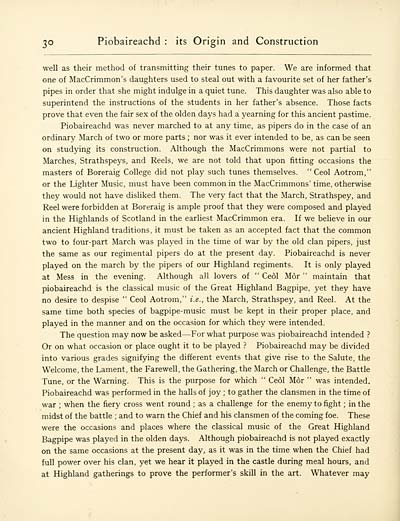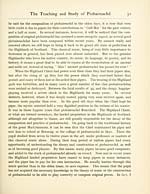Inglis Collection of printed music > Printed text > Piobaireachd [Tus is Alt a'Chiuil-Mhoir]
(36) Page 30
Download files
Complete book:
Individual page:
Thumbnail gallery: Grid view | List view

30 Piobaireachd : its Origin and Construction
well as their method of transmitting their tunes to paper. We are informed that
one of MacCrimmon's daughters used to steal out with a favourite set of her father's
pipes in order that she might indulge in a quiet tune. This daughter was also able to
superintend the instructions of the students in her father's absence. Those facts
prove that even the fair sex of the olden days had a yearning for this ancient pastime.
Piobaireachd was never marched to at any time, as pipers do in the case of an
ordinary March of two or more parts ; nor was it ever intended to be, as can be seen
on studying its construction. Although the MacCrimmons were not partial to
Marches, Strathspeys, and Reels, we are not told that upon fitting occasions the
masters of Boreraig College did not play such tunes themselves. " Ceol Aotrom,"
or the Lighter Music, must have been common in the MacCrimmons' time, otherwise
they would not have disliked them. The very fact that the March, Strathspey, and
Reel were forbidden at Boreraig is ample proof that they were composed and played
in the Highlands of Scotland in the earliest MacCrimmon era. If we believe in our
ancient Highland traditions, it must be taken as an accepted fact that the common
two to four-part March was played in the time of war by the old clan pipers, just
the same as our regimental pipers do at the present day. Piobaireachd is never
played on the march by the pipers of our Highland regiments. It is only played
at Mess in the evening. Although all lovers of " Ceol Mor " maintain that
piobaireachd is the classical music of the Great Highland Bagpipe, yet they have
no desire to despise " Ceol Aotrom," i.e., the March, Strathspey, and Reel. At the
same time both species of bagpipe-music must be kept in their proper place, and
played in the manner and on the occasion for which they were intended.
The question may now be asked — For what purpose was piobaireachd intended ?
Or on what occasion or place ought it to be played ? Piobaireachd may be divided
into various grades signifying the different events that give rise to the Salute, the
Welcome, the Lament, the Farewell, the Gathering, the March or Challenge, the Battle
Tune, or the Warning. This is the purpose for which " Ceol Mor " was intended.
Piobaireachd was performed in the halls of joy ; to gather the clansmen in the time of
war ; when the fiery cross went round ; as a challenge for the enemy to fight ; in the
midst of the battle ; and to warn the Chief and his clansmen of the coming foe. These
were the occasions and places where the classical music of the Great Highland
Bagpipe was played in the olden days. Although piobaireachd is not played exactly
on the same occasions at the present day, as it was in the time when the Chief had
full power over his clan, yet we hear it played in the castle during meal hours, and
at Highland gatherings to prove the performer's skill in the art. Whatever may
well as their method of transmitting their tunes to paper. We are informed that
one of MacCrimmon's daughters used to steal out with a favourite set of her father's
pipes in order that she might indulge in a quiet tune. This daughter was also able to
superintend the instructions of the students in her father's absence. Those facts
prove that even the fair sex of the olden days had a yearning for this ancient pastime.
Piobaireachd was never marched to at any time, as pipers do in the case of an
ordinary March of two or more parts ; nor was it ever intended to be, as can be seen
on studying its construction. Although the MacCrimmons were not partial to
Marches, Strathspeys, and Reels, we are not told that upon fitting occasions the
masters of Boreraig College did not play such tunes themselves. " Ceol Aotrom,"
or the Lighter Music, must have been common in the MacCrimmons' time, otherwise
they would not have disliked them. The very fact that the March, Strathspey, and
Reel were forbidden at Boreraig is ample proof that they were composed and played
in the Highlands of Scotland in the earliest MacCrimmon era. If we believe in our
ancient Highland traditions, it must be taken as an accepted fact that the common
two to four-part March was played in the time of war by the old clan pipers, just
the same as our regimental pipers do at the present day. Piobaireachd is never
played on the march by the pipers of our Highland regiments. It is only played
at Mess in the evening. Although all lovers of " Ceol Mor " maintain that
piobaireachd is the classical music of the Great Highland Bagpipe, yet they have
no desire to despise " Ceol Aotrom," i.e., the March, Strathspey, and Reel. At the
same time both species of bagpipe-music must be kept in their proper place, and
played in the manner and on the occasion for which they were intended.
The question may now be asked — For what purpose was piobaireachd intended ?
Or on what occasion or place ought it to be played ? Piobaireachd may be divided
into various grades signifying the different events that give rise to the Salute, the
Welcome, the Lament, the Farewell, the Gathering, the March or Challenge, the Battle
Tune, or the Warning. This is the purpose for which " Ceol Mor " was intended.
Piobaireachd was performed in the halls of joy ; to gather the clansmen in the time of
war ; when the fiery cross went round ; as a challenge for the enemy to fight ; in the
midst of the battle ; and to warn the Chief and his clansmen of the coming foe. These
were the occasions and places where the classical music of the Great Highland
Bagpipe was played in the olden days. Although piobaireachd is not played exactly
on the same occasions at the present day, as it was in the time when the Chief had
full power over his clan, yet we hear it played in the castle during meal hours, and
at Highland gatherings to prove the performer's skill in the art. Whatever may
Set display mode to: Large image | Transcription
Images and transcriptions on this page, including medium image downloads, may be used under the Creative Commons Attribution 4.0 International Licence unless otherwise stated. ![]()
| Special collections of printed music > Inglis Collection of printed music > Printed text > Piobaireachd [Tus is Alt a'Chiuil-Mhoir] > (36) Page 30 |
|---|
| Permanent URL | https://digital.nls.uk/94537940 |
|---|
| Description | Scottish and English songs, military music and keyboard music of the 18th and 19th centuries. These items are from the collection of Alexander Wood Inglis of Glencorse (1854 to 1929). Also includes a few manuscripts, some treatises and other books on the subject. |
|---|
| Description | The Glen Collection and the Inglis Collection represent mainly 18th and 19th century Scottish music, including Scottish songs. The collections of Berlioz and Verdi collected by bibliographer Cecil Hopkinson contain contemporary and later editions of the works of the two composers Berlioz and Verdi. |
|---|

